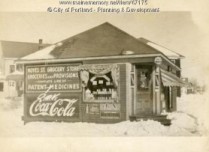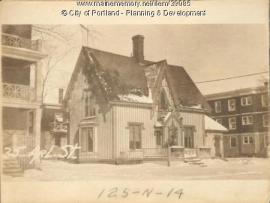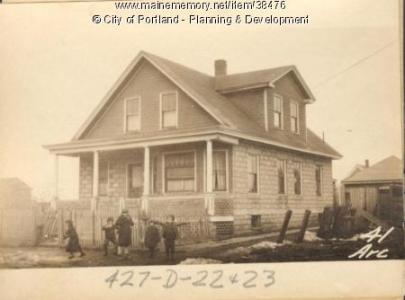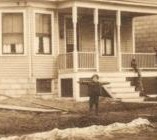 In 1924, every taxable property in the city of Portland, Maine, was reassessed, photographed and documented. The records were then bound into 131 books containing approximately 30,000 pages and stored at City Hall. And there they sat until recently when this remarkable, 88-year-old, newly digitized collection was made available to anyone with access to the Internet.
In 1924, every taxable property in the city of Portland, Maine, was reassessed, photographed and documented. The records were then bound into 131 books containing approximately 30,000 pages and stored at City Hall. And there they sat until recently when this remarkable, 88-year-old, newly digitized collection was made available to anyone with access to the Internet.

The photos take families with roots in Portland on a fascinating trip back in time to see the city their ancestors lived and worked in. And for current residents simply curious to know what their Portland home looked like in 1924, a high-resolution digital photo attached to the record provides a clear and detailed picture of the building.
 If the Portland collection consisted solely of photos, it would still be great, if not unique. New York City also shares old tax photos with the public, as does Seattle. But Portland’s inclusion of the reassessment documents online puts the city in a class of its own.
If the Portland collection consisted solely of photos, it would still be great, if not unique. New York City also shares old tax photos with the public, as does Seattle. But Portland’s inclusion of the reassessment documents online puts the city in a class of its own.
Each record contains the name of the property owner, the number of rooms and types of materials used to build the structure, its estimated age and general condition, and if a residence, how many families lived there. There’s also a hand drawn sketch of each building’s footprint and dimensions. The entire record is literally at your finger tips, easily searched by address, neighborhood, owner’s name and other categories and key words.
I’ve never been to Maine and have no ancestors from the area, yet I found plenty to do and explore on this website. Trying to match the photo of a 1924 building to its 2012 address using Google’s Street View can be fun, and challenging. Many of the old buildings no longer exist, and those that do often have added a room, enclosed a porch or have huge leafy trees blocking the street view, making it difficult to know if you have the right house or not. But most of the time you will be rewarded with “Then and Now” pictures that show how the house and neighborhood have held up over the years.


As I was browsing the collection, one photo in particular caught my eye.  It showed five kids of varying ages playing in front of 41 Arcadia Street. The tax form revealed that the home belonged to Carmela Cipriano. Cross-referencing her name with the 1920 U.S. Census showed that she and her husband, Antonio Cipriano, a laborer on the railroad, lived on Arcadia Street in 1920. The Ciprianos were Italian immigrants and had seven children by 1920, four girls and three boys. I presume five of them are the kids we see in the 1924 photo.
It showed five kids of varying ages playing in front of 41 Arcadia Street. The tax form revealed that the home belonged to Carmela Cipriano. Cross-referencing her name with the 1920 U.S. Census showed that she and her husband, Antonio Cipriano, a laborer on the railroad, lived on Arcadia Street in 1920. The Ciprianos were Italian immigrants and had seven children by 1920, four girls and three boys. I presume five of them are the kids we see in the 1924 photo.
I also looked up Carmela in the 1930 census and learned that she was living in the same house and now had twelve children, five boys and seven daughters. It was a decade defined by the Great Depression that brought fear and uncertainty into households across the land. It was an especially tragic time for the family living at 41 Arcadia Street.
According to the 1930 census, Carmela Cipriano was now a widow, with her youngest child just a year old. One can only imagine the hardships she endured raising twelve children alone without Antonio. But she and her family survived. The 1940 census has Carmela and five of her children still living at 41 Arcadia Street. Two sons worked at a canning factory and Carmela rented a room to a young married couple for $8 a month. It’s the story of a family’s perseverance through hard times told here thanks to records now available online.

Visitors to the website may discover much more than they expected. I found other photos among the collection that contain shots of people a relative might recognize. Here’s a picture of a young boy taken outside 29 Arcadia Street, just down the street from the Ciprianos. The tax record lists Ferdinando Fasulo as the owner. The boy in the photo could be one of Ferdinando’s eight sons. Hopefully, descendants of the Ciprianos and Fasulos will hear about the records of their old family homes and share them with their relatives.
Providing Internet access to the 1924 Tax Records is a group effort of the City of Portland, The Maine Historical Society, The Portland Public Library and The Maine Memory Network. But only about half of the books containing the tax records have been digitized and placed online. More funds are needed to insure that the remaining books are added to the database. If you want to help, please contact the project partners through their links above.
To access the 1924 Tax Records, click here.

Very nice – Your post has been picked up by the Fasulos of Portland – plenty of them still in Portland and reviewing via Facebook!
Glad you liked the post and that the Fasulos got to see it. Hope the Ciprianos also hear about it.
41 Arcadia
I married the youngest
Have photo of family outside house
Will share
Andreabecker1@hotmail.com or
Andd Becker facebook